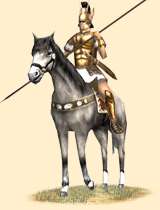Eqvites Extraordinarii (Elite Heavy Cavalry of the Italic Allies)
 |
Weapons | Defence | Mental | ||||||
|---|---|---|---|---|---|---|---|---|---|
| Primary | Secondary | Armour: | 13 | Morale: | 15 | ||||
| Type: | spear | sword | Shield: | 0 | Discipline: | disciplined | |||
| Attack: | 4 | 9 | Skill: | 9 | Training: | highly_trained | |||
| Charge: | 34 | 15 | Recruitment | Other | |||||
| Lethality: | 0.38 | 0.11 | Soldiers: | 25 | Hit Points: | 1 | |||
| Range: | 0 | 0 | Cost: | 3088 | Mass: | 1 | |||
| Ammo: | 0 | 0 | Upkeep: | 772 | |||||
| Turns: | 1 | ||||||||

In a consular army the best third of the allied cavalry is selected to serve as extraordinarii. These are Italia’s best horsemen, fighting as lance armed shock cavalry.
The consuls can enroll the troops of the socii in all regions of Italia.
In a standard consular army the best third of the socii cavalry and the best fifth of their infantry are selected to serve as Extraordinarii, a special unit under the direct control of the consul, available for decisive maneuvres. On the march they are the advance or rear guard, defending the army against possible attacks.Equites Extraordinarii are the finest horsemen Italia can field, mostly drawn from the aristocracy of the horse breeding regions. Especially campanian cavalry proved to be a valuable addition for every roman army and many of them were picked as Equites Extraordinarii. Armed with Greek xyston lances and kopis slashing swords, they normally fight as shock cavalry, spared in battle for the decisive attack. To show their position in society most riders wear elaborately decorated armour, mainly bronze muscle cuirasses, attic helmets and greaves.
Historically, quite a few regions of the Italian peninsula were well suited for horse breeding and their aristocracy provided the bulk of the cavalry for the roman armies. Especially the horsemen from Campania, that came under Roman rule in the 4th century BC were famous for their qualities. The campanians' large horses and their well trained riders, coming from an equestrian nobility with its own strong traditions, made them the one of the most respected cavalry in Italia.
The structure of the roman society and the position of the ordo equester as part of the leading classes made it impossible to supply the armies of the Res Publica with a sufficient number of citizen cavalry, so the socii, the Italic allies of the Romani, and their horsemen had to fill the gap. In roman service every eques sociorum had two horses and was accompanied by a groom.
When a republican roman army was enrolled the socii were ordered to send troops as well and to join the roman forces on a decided place. Usually, their infantry equalled that of the Romans while their cavalry was three times as numerous. In a standard consular army composed of two legions the remainder of their troops, extraordinarii aside, were divided into two equal sized units. Called ala sinistra and ala dextera (left and right wing) for being placed on the flanks of the similar sized legions.
During the 2nd century BC non Italic auxiliary cavalry increasingly replaced the socii as the dominant part of most armies mounted contingent and after the social war their distinctive units disappeared when most inhabitants of Italia received full citizenship and were directly recruited into the legions.